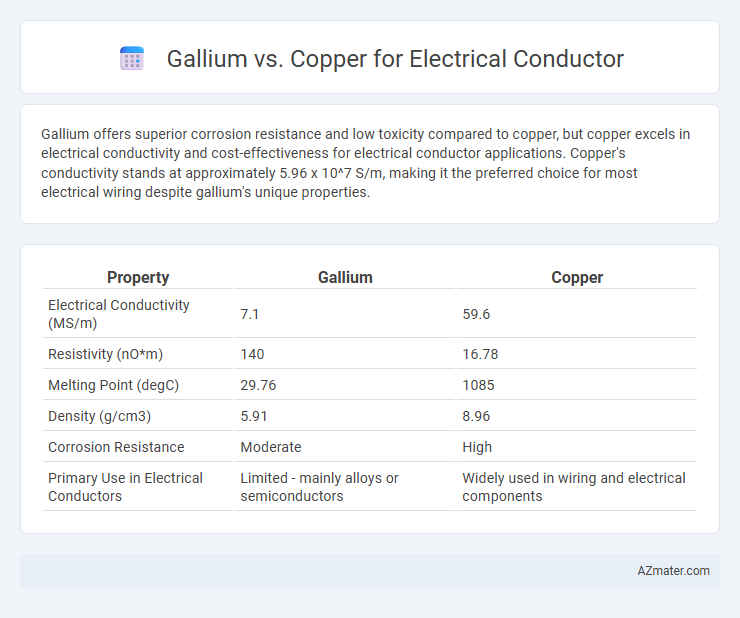Gallium offers superior corrosion resistance and low toxicity compared to copper, but copper excels in electrical conductivity and cost-effectiveness for electrical conductor applications. Copper's conductivity stands at approximately 5.96 x 10^7 S/m, making it the preferred choice for most electrical wiring despite gallium's unique properties.
Table of Comparison
| Property | Gallium | Copper |
|---|---|---|
| Electrical Conductivity (MS/m) | 7.1 | 59.6 |
| Resistivity (nO*m) | 140 | 16.78 |
| Melting Point (degC) | 29.76 | 1085 |
| Density (g/cm3) | 5.91 | 8.96 |
| Corrosion Resistance | Moderate | High |
| Primary Use in Electrical Conductors | Limited - mainly alloys or semiconductors | Widely used in wiring and electrical components |
Introduction to Electrical Conductors
Gallium and copper are distinct materials evaluated for use as electrical conductors, with copper being the industry standard due to its high electrical conductivity of approximately 5.96 x 10^7 S/m at room temperature. Gallium, while not traditionally used as a bulk conductor, offers unique properties such as a low melting point (29.76degC) and the ability to form conductive alloys and liquid metals, potentially enabling flexible or novel conductor applications. Copper's superior mechanical strength and corrosion resistance further cement its role in electrical wiring, whereas gallium is more suited for specialized uses in electronics and semiconductor industries.
Gallium: Properties and Applications
Gallium exhibits a unique combination of a melting point near 29.76degC and excellent electrical conductivity, making it suitable for specialized electrical conductor applications where liquid metal contacts are required. Its ability to remain in liquid form just above room temperature allows it to be used in thermally adaptive circuits and flexible electronics, offering advantages over traditional solid copper conductors. Gallium's low toxicity and corrosion resistance further enhance its application potential in sensors, high-performance switches, and thermal interface materials.
Copper: Properties and Applications
Copper exhibits exceptional electrical conductivity at approximately 5.96 x 10^7 S/m, making it a preferred choice for electrical wiring and components. Its high thermal conductivity, ductility, and resistance to corrosion contribute to reliable performance in power generation, telecommunication cables, and electronic devices. These properties, combined with its abundance and recyclability, solidify copper's dominance over alternatives like gallium in electrical conductor applications.
Electrical Conductivity Comparison
Gallium exhibits significantly lower electrical conductivity than copper, with copper's conductivity at approximately 5.96 x 10^7 S/m compared to gallium's roughly 6.3 x 10^6 S/m. Copper's superior conductivity makes it the preferred material for most electrical wiring and conductor applications, owing to minimal resistance and efficient energy transfer. Gallium, while a semiconductor with unique properties, lacks the high conductivity necessary for primary electrical conductor roles in power distribution.
Thermal Conductivity Differences
Gallium exhibits significantly lower thermal conductivity compared to copper, measuring approximately 29 W/m*K versus copper's superior 401 W/m*K at room temperature. This disparity in thermal conductivity impacts heat dissipation efficiency, making copper the preferred choice in applications demanding rapid and effective thermal management. Although gallium's electrical conductivity is notable, its thermal properties limit its use as a conductor where heat transfer is critical.
Cost Analysis: Gallium vs Copper
Copper remains the dominant electrical conductor due to its cost-effectiveness, with prices averaging around $9 per kilogram compared to gallium's significantly higher price, often exceeding $300 per kilogram. Gallium's production involves more complex extraction and refining processes, contributing to its elevated cost and limited use in large-scale electrical applications. Despite gallium's superior conductivity under specific conditions, copper's affordability and widespread availability make it the preferred choice in cost-sensitive electrical infrastructure projects.
Durability and Longevity
Gallium exhibits poor durability and low mechanical strength compared to copper, making copper the preferred choice for electrical conductors where longevity is critical. Copper's high resistance to oxidation and excellent tensile strength ensure sustained conductivity and minimal degradation over extended periods. Gallium's tendency to oxidize quickly and its softness limit its practical applications in durable electrical wiring and devices.
Environmental Impact and Sustainability
Gallium, as an electrical conductor, offers lower environmental impact compared to copper due to its abundance in byproducts of mining and potential for recycling, minimizing resource depletion. Copper mining involves significant land disturbance and energy consumption, contributing to habitat loss and higher carbon emissions. Gallium's improved recyclability and reduced mining footprint enhance sustainability prospects in conductor applications.
Emerging Technologies and Innovations
Gallium offers promising advantages over copper in emerging technologies due to its superior flexibility and lower melting point, facilitating innovative applications in flexible electronics and advanced semiconductor devices. Despite copper's higher electrical conductivity and well-established infrastructure, gallium's compatibility with gallium-based compounds enables breakthroughs in high-frequency and optoelectronic components. Innovations in gallium-based conductive materials and alloys are driving new frontiers in wearable sensors, soft robotics, and energy-efficient circuitry, positioning gallium as a key material in next-generation electrical conductors.
Future Prospects in Electrical Engineering
Gallium demonstrates unique semiconductor properties and superior corrosion resistance that could revolutionize future electrical conductor applications compared to copper's traditional dominance due to high conductivity and affordability. Research into gallium-based alloys and composites aims to enhance flexibility and thermal stability, critical for next-generation electronic devices and flexible circuits. Innovations in gallium extraction and cost reduction may position it as a strategic material in high-performance and miniaturized electrical engineering components.

Infographic: Gallium vs Copper for Electrical Conductor
 azmater.com
azmater.com